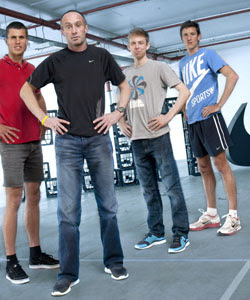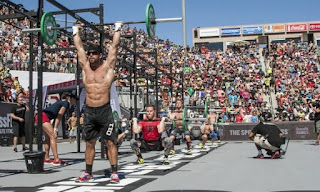"Nature's Arena has a way of humbling and energizing us." Scott Jurek
We are always looking to up the ante especially in sports. The current health and fitness renaissance has shown us the old standards of workload are only the floor not the ceiling. The arrival of Crossfit proved that workload could be and should be expanded. This has started to spill over into traditional endurance events changing there landscape as well. No pin intended. I am talking specifically about alternative or adventure races like Warrior Dash, Tough Mudder, Spartan Race, Run for you lives, Men’s health Urbanalathon and the Merrell Down & Dirty obstacle race. Lets look at the races in no particular order:
Warrior Dash is a 5k obstacle course race, with 17 obstacles. The obstacles include Muddy Mayhem, Warrior Roast, Cliff Hanger, Trenches, Barracade Breakdown, Cargo Climb, Great Warrior Wall, Giant Cliffhanger, Deadlift Drifter, Hard Rain, Leaders Ledge, Mortimers Crossing, Mud Mounds, Petrifying Plunge, Road Rage, Storming Normandy and Vicious Valley. Your prize for finishing the race is a turkey leg and a cold beer. The proceeds from the Warrior Dash go for a good cause the St. Judes Childrens Research Hospital. There are dashes being held around the country at different times of the year.
Tough Mudder events are hardcore 10-12 mile obstacle courses designed by British Special Forces. They test you strength, stamina, mental grit and camaraderie, it is said only 78% of the entrants finish. It has raised over $5 million for the Wounded Warrior Project. It has 24 obstacles Arctic Enema, Bale Bonds, Berlin Walls, Boa Constrictor, Cliffhanger, Devils Beard, Dirty Ballerina, Dong Dangler, Electric Eel, Electroshock Therapy, Everest, Fire Walker, Funky Monkey, Greased Lightning, Hanging Tough, Hold Your Wood, Kiss of Mud, Mud Mile, Spiders Web, Trench Warfare, Twinkle Toes, Underwater Tunnels and Walk the Plank. Once you cross the finish line you get the Tough Mudder headband, a high five and a Dos Equis beer.
Spartan Race is a series of obstacle races in varying distances ranging from 1 mile to a full marathon. This is the breakdown Spartan Sprint 3 plus miles, Super Spartan is 8 plus miles, Spartan Beast is 12 plus miles, and the Ultra Beast is 26 miles one of two marathon courses with Mudderthon. You get a finisher medal, race shirt and a post race party. The obstacles include Fire Jump, Barbed wire crawl, Over under tough, Spear throw, Wall Climb, Object carry, Herculean hoist, Tryolean traverse, Traversal wall, Slippery wall, Gladiator arena, and the Hobie hop. The Spartan Races are held worldwide.
Run for your Lives is another 5K obstacle course for the Zombie set. You will not only encounter these obstacles the Blood Pit, Smokehouse and the Maze. But you will need to outrun the zombies! After or if you finish you have the Apocalypse Party, that has food , music, vendors and games. They have partnered with a charitable organization the Kennedy Krieger foundation for kids battling brain injuries and disorders.
Men’s Health Urbanathlon is a three city series of events comprised of 9.1 to 11 mile endurance races that incorporate city landmarks and urban obstacle courses set on the streets of the tree largest cities in the U.S. The obstacles may include Barricades or Fence Crawl, Tires or Police Barricades, Monkey Bars, Over Under and Thru, Cargo Net Crawl, Stair Climb, Hurdles, a Stadium Stair Climb and the Finish Sequence. Post race is a festival with DJ sets, food and drink and tons of stuff from sponsors. The charity they work with is the Challenged Athletes Foundation. They are held in Chicago, New York and San Francisco.
I have one more race for you to consider this one is not a adventure race like the above named events. It is the granddaddy of all Ultra Races the Western States Endurance Run. It is a 100 mile raced that spurred on the sport of ultra distance trail running in the U.S. It came from a horse race when Gordy Ainsleigh’s horse came up lame in 1974, he decided to run the entire course through the Sierra Nevad Mountans himself. It is now noted as the Boston Marathon of Trail running, attracting the best trail runners from around the world. Past champions have included 5 time winner Scott Jurek.
I wrote this so that you can see what is out there. We all need challenges from time to time and running regular races is not for everyone nor is working out in a gym. At times you will need to change it up. Now you have some examples of how to do that. The great things about these events are they are social, have a charity partner and don’t take themselves to seriously. Please read and share this blog.













































